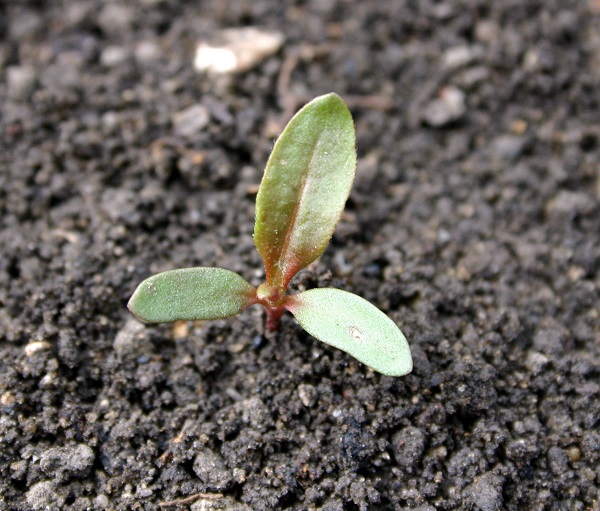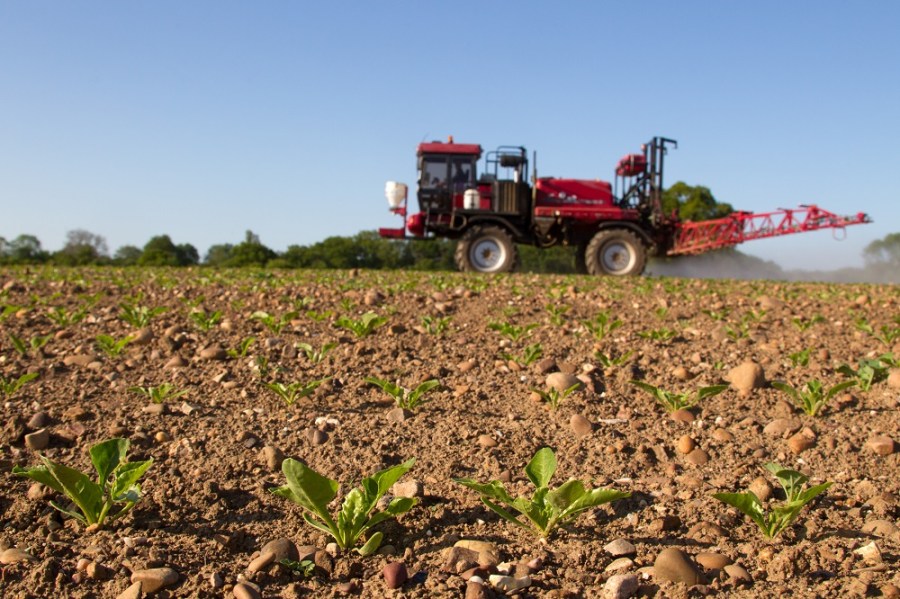Good establishment and weed control are both essential for high-yielding crops of sugar beet. CPM looks at two different approaches to getting crops off to a good start.
Controlling weeds early in sugar beet is vital.
By Lucy de la Pasture and Rob Jones
Soil management and weed control are the priorities for Chris and Marcus Rutterford in establishing beet crops that go on to yield 80-90 t/ha. Farming 410ha at Swaffham in West Norfolk, the cousins grow 70ha of sugar beet in rotation with winter cereals, spring barley and maize for biogas on land, which Chris describes as ‘mostly light and some heavy with it’. He says that moisture conservation and seedbed quality are critical factors in growing a successful crop of sugar beet on his farm.
Preparation for the coming crop begins in the New Year with muck spreading and application of base fertiliser. They then subsoil, if necessary and if conditions allow – which Chris says they won’t this year – and plough in Feb. Seedbeds are prepared with a single pass of a Kongskilde Optimator working to a depth of just 30mm.

An even plant stand makes weed control and lifting much easier. Ideally seedlings should emerge simultaneously.
“It’s important to work from the top and leave an undisturbed base at 30mm where the seed will be placed. We don’t want to be pulling up soil any deeper than that and losing moisture. We look at each field individually and aim to disturb the soil as little as possible.”
Drought worries also focus their minds on early establishment, so typically they are half drilled by mid-March. “If we’re still drilling into April then we’re pressing the panic button,” Chris says.
The Rutterfords drill 1.2 units/ha and achieve a plant population of 100,000/ha and Chris is emphatic about the need for even establishment. “We want an even plant stand as it makes weed control and lifting so much easier and if we get the seedbed right, we’ll see the seedlings emerging simultaneously.”
Weed control begins with pre-emergence chloridazon to ‘buy time’ in case the first post-em spray is delayed. Their approach to weed control is driven as much by operational efficiency as efficacy.
“Like most growers we now run one main farm sprayer. It takes half a day to wash out properly, so we want as few passes as possible and for weed control to be safe, flexible and effective.”

Polygonums, such as redshank, can prove difficult to control in sugar beet.
Basing their weed control around Betanal maxxPro (phenmedipham+ desmedipham+ ethofumesate+ lenacil) gives the Rutterfords broad-spectrum weed control from just two passes, in three years out of four. The first post-em spray is pre-determined: a mix of Betanal maxxPro at 1.0 l/ha plus Goltix (metamitron) at 1.0 l/ha to ‘take out everything’. Chris believes this approach gives time to take a look around the fields and tailor the second spray to the next flush of weeds.
“Depending on what we see coming up next, we add Venzar (lenacil), Debut (triflusulfuron-methyl) or Shield (clopyralid) plus some oil and vary the Betanal maxxPro rate between 0.5 and 0.75 l/ha.
“Our principal targets are black bindweed, fat hen and knotgrass, depending on the season. Around one year in four we get a spring that begins dry then turns wet leading to a late flush of fat hen that needs a third spray,” he says.
Summing up his views on establishment Chris emphasises that 75% of a beet crop’s yield potential is about the seedbed. Weed control needs to be right because beet can’t compete and losses to weed competition can be monumental.
That’s a view Lincs-based Agrovista agronomist Tony Scarborough agrees with, adding that compromising weed control in sugar beet when pressure on gross margins continues to tighten can only be a counterproductive measure to maximising profitability.
There’s still a healthy profit to be made by growing sugar beet, despite the current price of only £23/t, he says, but early control of key competitive and yield-robbing weeds such as redshank, knotgrass, mayweed, brassica weeds and other polygonums remains a priority.
“Poor weed control can knock yields by as much as 30%, but with pressure on pre-em herbicides, which tend to coincide with other key spring farming operations, there’s now an even greater reliance on post-em contact and residual herbicide sprays,” he says.
“Controlling weeds early in sugar beet is vital if growers are to achieve a low unit cost of production and it’s the key to achieving higher yields,” says Tony.
He aims to hit broadleaf weeds hard and early, using a mix of contact and residual acting herbicides. “By the time a sugar beet crop has reached the six true-leaf stage, its yield has been set and it will easily compete with emerging weeds,” he believes.
Traditional herbicide strategies based on a ‘little and often’ approach have become largely redundant for a number of reasons, including a move by many growers to run a single, high-tech sprayer on the farm across a larger land area and a wider range of crops, he says.
When in this situation, he reckons the answer is to adopt a two-spray programme known as ‘broadacre’. “The first application is applied at the extended cotyledon stage, followed by a second application at two leaves. Mixtures are based on Safari Lite (triflusulfuron-methyl+ lenacil) plus Betanal maxxPro at 1.25 l/ha, and if weeds such as common thistle or sow thistle and volunteer potatoes are present, then clopyralid should be added at 0.3 l/ha.
“A programmed strategy to weed control in sugar beet is critical, with applications timed as flushes of weeds emerge. And it’s important that spray timings are based on the crop’s growth stage, because larger beet seedlings can cope better with stronger herbicide mixes,” he says.
“A wider spraying window also means the sugar beet can be left to grow larger before spraying. Hitting a little weed also means hitting a little beet and the beet is more susceptible when small,” adds Tony.
“Also, using a robust mix containing several different actives increases the window of opportunity, and this helps to takes the pressure off if earlier spraying opportunities were missed.”
Tony says that while there’s a potentially higher cost associated with the broadacre herbicide strategy, in order to adequately control weeds in sugar beet any system of control is going to cost money.
“Growers either pay for the chemicals by spreading the applications out over four or five passes during the season or by adopting a broadacre system, where they save on application costs,” he says.
“It’s really about effectiveness of the programme and the timing. Broadacre represents a much more flexible herbicide programme that only requires one operator and one sprayer.”
Chile trip on offer for growers
To support growers intent on pushing sugar beet yields higher, Bayer is offering the chance of a trip to Chile for two growers making significant progress in raising performance. Chilean grower Barbara Becker, who farms south of the capital Santiago, set a new world record in 2017 with an adjusted yield of 196.7t/ha.
Bayer’s #Beet150 will reward the registered grower with the highest yielding sugar beet contract in the 2018-19 season, and the grower with the highest yielding individual field lifted before 30th Nov.
Edward Hagues, Bayer root crops campaign manager, explains that participating growers will receive regular advice and support during the season.
“We want to see what the highest possible UK yield is. We’re asking participants to push the crop to its limits and see if 2018 can be the year that a record of 150t/ha is achieved.”
To support growers Bayer is offering on-farm advice from its team of technical managers and external consultants, aerial crop surveillance to promote weed, nutritional and disease management, soil nutrient analysis to identify deficits and inform decisions as to how they may be corrected, and root digs to inform yield forecasts.
The competition is open to all British Sugar growers, but those wishing to take part must complete the entry form on the Bayer website (www.cropscience.bayer.co.uk/beet150) before 29 Mar. In addition, growers interested in following the fortunes of entered growers and picking up tips and advice on growing their own crops can sign up through the Bayer website for regular updates.
Potato growers gain new blight fungicide
Brand new chemistry to tackle foliar and stem blight in UK and Irish potato crops has been approved and will be available for the 2018 season.
Zorvec Enicade (oxathiapiprolin) from DowDuPont is much anticipated in the industry following many years of impressive performance in domestic trials and has proven to deliver robust control across three continents, where it’s already available to growers.
It will push the boundaries of traditional spray programmes by delivering a 10-day persistence following application – three days more than current practice permits with other blight fungicides.
Protective and curative, with demonstrable movement into new growth, Zorvec Enicade’s greatest benefit may be gained by targeting the crop’s rapid growth stage. Application to stems as well as leaves results in stem blight control, helping get the blight programme off to a good start.
Craig Chisholm, UK field technical manager for DowDuPont, says, “Growers and agronomists have seen demonstrations of Zorvec Enicade’s performance over several seasons and will be excited that it’s now registered for use in the UK and Ireland.
“Spray intervals of up to 10 days will be something new for growers to consider, but we feel they will immediately see the benefit of the added flexibility it offers, plus the opportunity to reduce one spray pass when this 10-day strength is utilised in a spray block.
Zorvec Enicade is suitable for use in both ware and seed crops across all varieties but is expected to appeal most for use in crops with an indeterminate growth habit or destined for long-term storage.
Sprayed at the start of the rapid growth phase, the molecule sticks to the wax layer of both stem and leaf offering 10-day persistence in control. It binds quickly and moves within the plant as it extends, protecting new leaves and stems.
“By ensuring no infection is sporulating under your crop canopy – achieved with back-to-back sprays at the rapid growth stage – blight pressure over the rest of the programme will be greatly reduced and you still have one or two Zorvec sprays in reserve,” explains Chris.
Zorvec Enicade is supplied with a partner fungicide which has a different mode of action – an essential component in an anti-resistance strategy developed to protect this new chemistry for the long term.
“There’s concern about the aggressiveness of blight and there’s no doubt the challenges we face are increasing. We need new chemistry and Zorvec Enicade is effective against all strains – including 37_A2 – with no cross resistance.”




